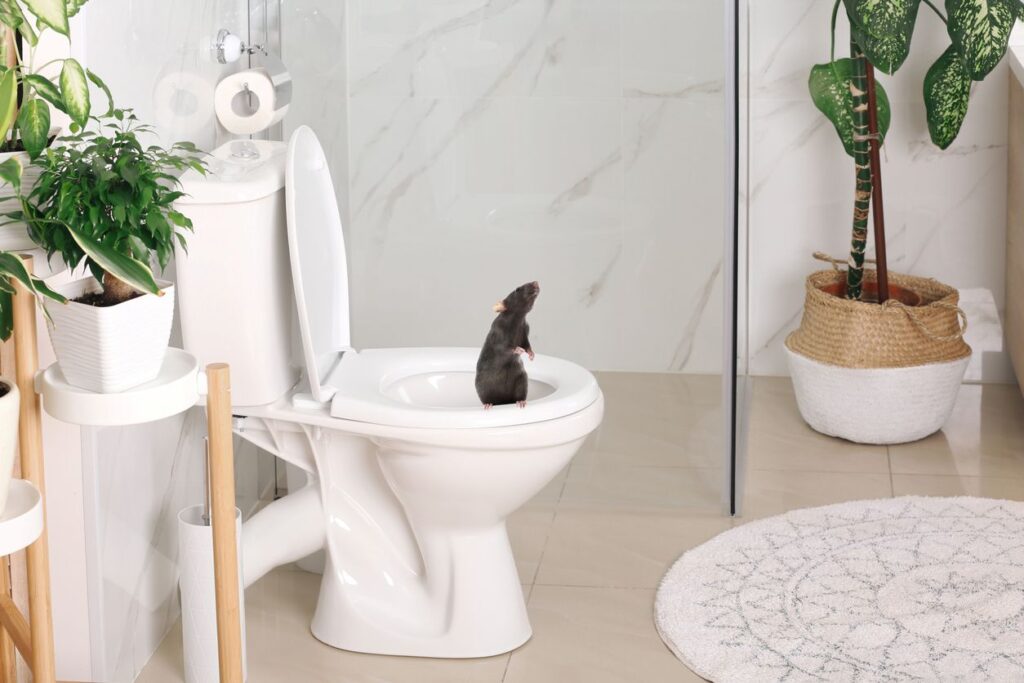Can Rats Come Up Through Your Toilet?

Absolutely! Not only can rats swim through narrow, winding pipes to get into your home, but it’s actually a fairly common occurrence. Rats congregate underground where food and shelter are plentiful, and what place could be more welcoming than the sewer?
That’s no joke if you are a rat, and it’s the primary reason why these rodents can seemingly appear from nowhere in your toilet bowl. Let’s dive into what happens when a rat swims up the sewer into your toilet, and how help from Advanced IPM can keep them away.
How Well Can a Rat Swim?
In all likelihood, an ordinary rat can swim farther, longer, and more efficiently than you.
The average human can hold their breath for approximately 90 seconds, but this duration is significantly reduced during activities that require physical exertion, especially swimming. While some trained swimmers can hold their breath for longer, humans are not naturally adapted to paused breathing, which limits our endurance in unfavorable conditions where oxygen is scarce.
Rats, in comparison, can easily hold their breath for three minutes without issue. They’re agile, highly efficient swimmers that are also naturally buoyant, meaning rats can float to regain energy when given the opportunity.
All this means rats can swim through even the most restricted areas for hours on end. Rats swim in natural, often hostile environments, such as sewers, flooded pipes, or streams. When they head upcurrent, the wide pipes extending from your bathroom are where they often emerge.
What to Do if You Find a Rat in Your Toilet
The first step after finding a rat in your toilet is not for the faint of heart. You need to know whether or not it is alive. Even if you see no movement, a quick poke with the end of a toilet plunger can give you your answer.
A dead rat is easier and safer to remove. If the rat is alive, all you need is a bit of dish soap. Pour the detergent in and around the water to cause the rodent to tire and sink, as it will be unable to tread water.
From there, it may be possible to flush the rodent back down the toilet, but be careful. An overflowing toilet can easily lead to other pest problems, so when in doubt, it’s best to call in professional pest control.
Yes, rats are strong swimmers and can navigate through sewer lines into your toilet bowl. It’s rare, but it does happen—especially in older homes or cities with aging plumbing infrastructure.
Rats typically enter sewer systems through broken pipes, open drains, or maintenance holes. From there, they can climb and swim their way into homes through unsealed plumbing.
Stay calm, close the toilet lid, and add dish soap to reduce its ability to climb or breathe. Call pest control for safe removal and to inspect your plumbing.
Install a one-way valve or sewer gate, seal plumbing gaps, and ensure your toilet lid stays closed when not in use. Regular plumbing inspections help too.
Signs include strange gurgling sounds, foul odors, scratching or squeaking noises near pipes, and unexplained water backup.
How to Get Rid of Rats in Your House
From pipe to porcelain, rats can make easy work of your plumbing as they infest your home.
That’s where preventive maintenance and recurring inspections from Advanced IPM come in. Our experts in rodent control and exclusion utilize industry-leading tools and techniques to eliminate any existing rodents from your home while deterring future invaders through the use of barriers, traps, and routine inspections.
Through minimal use of chemical methods and careful attention to detail, we can keep your entire home secured so you can rest easy in your restroom.
Contact Advanced IPM to schedule your rodent control inspection and treatment today.
